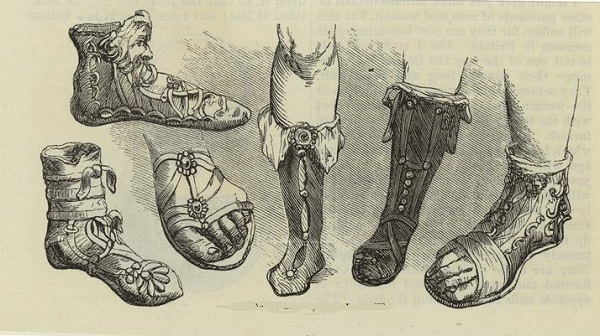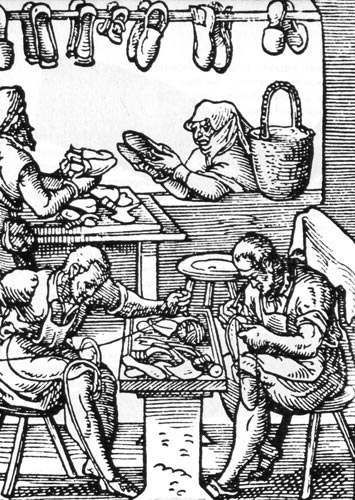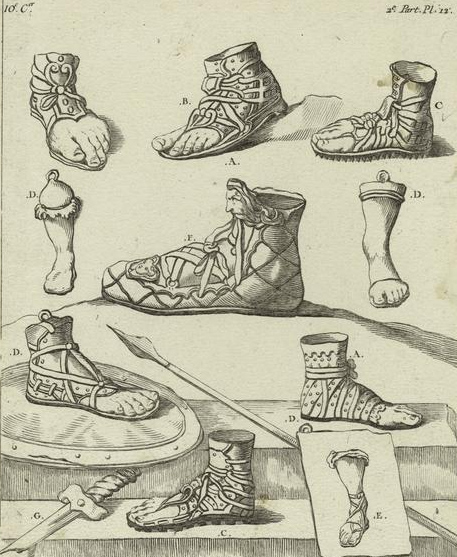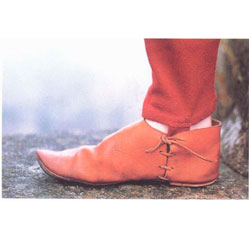The history of footwear: from antiquity to the present day
Everyone will agree that buying new shoes is one of the most effective ways to combat stress. And each of us, when buying another pair of sneakers or sneakers, pays attention to quality, size, comfort and other factors, but does not think about how the shoes appeared, without which we now cannot imagine our lives. The wide range of styles and styles of shoes reflect the incredibly rich and long history of the mundane item of clothing. And the first pairs of shoes appeared several hundred years BC.
First appearance of shoes
American historians believe that shoes first appeared 26-30 thousand years ago in the western part of Eurasia. After analyzing the skeleton of people who lived during the Middle and Late Paleolithic period, they paid attention to the little toe and noticed that with each new generation it became weaker, therefore, the shape of the foot changed. In their opinion, such changes are precisely due to the fact that they wore tight shoes.
Due to the sharp cooling and the development of new civilizations, ancient people began to dress in animal skin and wrap their legs in leather. Paleontologists believe that the first shoes in the history of mankind were something similar to army foot wraps made of animal skins, which were insulated from the inside with dry grass, and bast wood was used to attach them to the leg. But to this day, ancient shoes with insoles made of hay have not been able to survive.
The emergence of shoes in various world cultures
Ancient Egypt
On the territory of Ancient Egypt, in the temples and in the palace of the pharaoh, you only had to walk barefoot. But in everyday life, the Egyptians protected their feet from hot sand with shoes similar to sandals. At that time, all shoes were sewn using the same pattern without taking into account the natural curve of the foot, so such shoes were not entirely comfortable. The soles of the shoes were made from palm leaves or papyrus, and were attached to the foot using leather straps. The rich people of Egypt decorated the straps on their sandals with various paintings, precious and semi-precious stones. During archaeological excavations, shoes were found that vaguely resembled closed-toe slippers without a back.

Ancient Greece
It was in Greece that the history of the appearance of shoes gained incredible momentum. This is where the famous classic flat sandals with high lacing appeared. Each of us has seen similar shoes in various historical films. Greek hetaeras were considered the trendsetters of women's shoe fashion, who had the right to visit places with a concentration of men.

It was on their order that the shoemaker nailed the shoes so that they left footprints in the sand with the inscription “Follow me.” This was a true revolution in the production of shoes - at that moment the division of shoes into left and right began, so at that moment the first pair of shoes appeared.
At first, the main element of footwear was crepides - standard sandals, which were a regular sole with a side and a heel, on which the straps were intertwined around the ankle, emphasizing the slenderness of the legs. Later, women from Greece held in high esteem endromids - high carved boots, which consist of a sole and leather tops that cover the back of the leg. The front is laced and the toes are left open.
Ancient Rome
On the territory of Ancient Rome, shoes performed status and utilitarian functions. Each social class had its own personal form of shoes. Casual women's shoes were white, and men's were black. Exclusively for special occasions, wealthy residents of Rome wore purple and scarlet shoes, which were decorated with embroidery and pearls.

Plebeians and patricians wore leather sandals that only covered the sole of the foot and were attached to the foot with straps. Exclusively the shoes of the nobility were attached to the foot with four straps, and for the plebeians - with one strap. Commoners wore special shoes that completely covered the foot and were tied in front with a lace or ribbon. Appearing in a public place with open shoes is bad manners. Soldiers wore strong boots that were nailed down, and actors wore special rope slippers.
Scythian tribes
The ancestors of the Eastern Slavs, the Scythians, also had their own type of shoes. These are soft high boots that were tucked into pants. Such boots perfectly fitted the leg, reminiscent of a leather stocking. The shoes were secured with straps, covering the foot and ankle. Under the boots, the Scythians wore felt stockings with a felt sole sewn on, and on top of the stocking was straightened out over the boot. Over the stockings they wore boots with a soft head made of leather, with tops and knees - so that the ornamented tops of the stockings were visible.
A woman from a Scythian tribe wore low ankle boots, which were worn over felt stockings edged with red braid. Women's boots were made from thin red leather and were rich in ornaments. At the junction of the boot and head, a special strip with red wool braid was sewn in, which was decorated with leather appliqué. The sole is also finished in a rather original way - beads, leather and thread were used for dyeing.
The history of the appearance of shoes in Europe - our era
In the Middle Ages, Europe was simply distinguished by the incredible pretentiousness of its shoes and outfits. Open shoes were not recognized, so no one wore them in high society, giving preference only to closed models of shoes with long and upturned toes. Considering the fashion of that time, the tip of the nose was decorated with bells or bells. King Philip IV of France issued a special law according to which everyone had to wear only closed shoes.
In the 14th century, the length of the toe of a shoe was used to judge the nobility and wealth of the owner. The princes' shoes were three centimeters longer than the foot. Boots for a baron are two centimeters, shoes for an ordinary nobleman are 1.5 centimeters longer than the natural size of the foot. Naturally, wearing such shoes was simply incredibly uncomfortable, so in order to avoid stumbling, the toe had to bend upward, and for reliability, they were tied to the foot using a leather lace and twine.

If you believe historians, the most ancient shoes on the territory of modern Ukraine are considered to be pistons - shoes that were made from soft leather. Facts about the history of footwear in Russia and Ukraine confirm that noble and wealthy people wore bright, morocco boots, decorated with rich details. The poor man wore boots made of rough leather, bast bast shoes with onuchs - modern foot wraps and frills - strings.
Relief for every European came in the 15th century, when shoes with long narrow toes were replaced by wide short shoes. Gradually, shoes with blunt toes began to come into fashion. With the expansion and increase in the front part of the shoe, the back part narrowed and decreased, and already in the 20s of the 16th century, the shoes became so small that they could barely stand on their feet, so they were fastened with ties at the instep.
The period of the 17th-18th century was a real boom for women's shoes. Various developments have occurred in the history of clothing, such as skirts becoming playful and shorter. The rough shoe was replaced by an elegant and light shoe made of velvet, brocade and silk with an elegant heel. In addition, the heel was borrowed from men - previously, only noble people wore shoes with heels while hunting and riding.
During the Rococo and Baroque periods, there were balls in every courtyard, so gallant gentlemen did not miss the opportunity to show off high-heeled shoes. It was this that led to the fact that men's and women's shoes were decorated with fabric ribbons, bows and beads. Shoes were made from silk, leather, velvet and wool fabric in blue, red and yellow. Boots with a wide rounded toe continued to be made from soft leather of a natural color. Commoners could not boast of such an abundance of shoes, so they wore ordinary rough wooden shoes.
In the 20th century, radical changes came to clothing and shoes - they came to the fore when creating a fashionable image. From an ergonomic point of view, two main trends were observed. On the one hand, men's and women's shoes were aimed at comfort, and on the other hand, formal shoes with high heels, etc., appeared in which you could go out into the world. It was at this time that innovation manifested itself in the fact that the shape of the shoe began to follow the contours of the foot - the insole became asymmetrical, rather than even.
As for our 21st century, shoes have actually reached their ideal and are presented in a wide range - shoes, boots, sneakers, moccasins and much more. Synthetic and natural shoe materials are used, which makes it possible to significantly reduce costs and bring the characteristics closer to natural materials. To make the sole, rubber, plastic, leather and wood are used.
Where to buy high-quality and modern shoes in Ukraine?
Online store "World of Shoes" has made sure that you can buy only the best shoes from famous brands on favorable terms, just call us or leave a request on the website. We will always help you choose the optimal solution, taking into account your goals, preferences and financial capabilities. We cooperate directly with manufacturers, so prices are 10-15% lower than in other stores. We deliver throughout Ukraine: Lviv, Odessa, Nikolaev, Kharkov and other regions.
